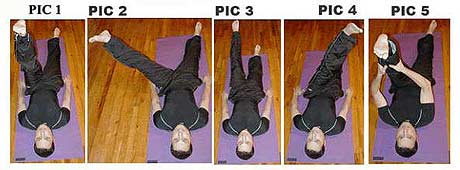Leg Circles Part I – Stretching the Hip Muscles
for Higher Kicks
By Paul Zaichik
Editor’s Note: This is the first
in a series of articles that focus on the hip joint and its muscles. Part
2 of this series will focus on extended length conditioning applied to
the leg circle.
The hip joint is located right below the midsection of the body, and
any force transfered into a technique must pass directly through it. Everyone
from beginner to advanced athlete knows that if you can incorporate the
hip into a technique, you can produce more force. In karate this translates
into greater impact.
If you can isolate the movers of the hip joint from the other muscles,
this allows the body to exploit degrees of freedom in the joint. Exercises
which focus on isolating the hip joint also foster long lasting health
and stability of the joint.
Leg circles are one of those exercises. This exercise was first introduced
byJoseph Pilates. Now the leg circle has found its way into dance, martial
arts and other athletic communities.
espite looking simple and straight forward, this exercise is extremely
effective for stabilization, isolation and control of the hip joint. As
far as martial arts is concerned, incorporating this technique into the
conditioning routine has incredible effect on the speed, power and control
of kicks, not to mention injury prevention.
o begin the exercise lie down on your back with hands by your sides and
both legs straight. Lift one leg toward the ceiling, press your lower
back onto the floor (you want to prevent an arch in the lower back) and
pull the naval toward the spine.
How low your leg will go (Picture 1) depends on your level of strength,
flexibility and control. Lower your leg to the outside. Do not allow your
back to shift. Keep the opposite hip on the floor. The whole movement
must be in the hip joint. Abdominal muscles only stabilize the movement.
(Picture 2)

Now lower the leg and bring it parallel to the other leg. The moving
leg should be a few inches away from the floor. Again try not to lift
your lower back off the floor. (Picture 3)
Now bring the leg up and over the other leg. This part of the movement
stretches the outside of the hamstrings. Most martial artists tend to
focus on the inner hamstrings stretches, and this exercise may be a good
way to bring balance to the back of the leg. As before, do not allow your
back or your buttocks to come off the floor. (Picture 4)
Repeat the exercise 5-10 times on each leg. Do not forget to circle the
leg in the opposite direction. The speed of the movement depends on your
level of conditioning at the moment. Ideally the leg should travel at
low to medium speed. This exercise loosens up the muscles surrounding
the hip joints. Try stretching the hamstring gently; you may be surprised
at the results. (Picture 5)
About the Author:
Paul Zaichik is the founder of the ElasticSteel
method of athletic conditioning. Although martial arts training
was not allowed in Eastern Europe when he was a child, Zaichik
trained in everything he could get his hands on -- fencing, wrestling
and boxing. When he later added gymnastics, dance and track and
field, he realized that while most athletes were flexible, they
could not do full splits or bring their feet above their heads.
In comparison ninety nine percent of the gymnasts and dancers
can sleep while having their legs in a full straddle. When Zaichik
took up martial arts in 1990, his former training allowed him
to throw 6 o’clock kicks and do full splits on demand. This
led to the development of a system which utilized many Eastern
European stretching and gymnastic techniques to meet the needs
of the modern martial artist. Zaichik supplemented his experience
by obtaining both an undergraduate and graduate degree in Exercise
Science and Nutrition. His research and expertise led to the creation
of a system of techniques known as ElasticSteel. His website is
ElasticSteel.com.
|
|